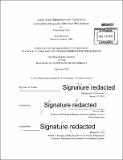Large scale simulation and analysis to understand enzymatic chemical mechanisms
Author(s)
Patel, Ishan Satish
DownloadFull printable version (12.49Mb)
Other Contributors
Massachusetts Institute of Technology. Department of Chemistry.
Terms of use
Metadata
Show full item recordAbstract
The full stack approach, from Biochemical Network Simulation to Quantum Mechanics, is developed and utilized to understand in this thesis to understand enzymatic mechanism. The story falls into two segments that highlight two different aspects of enzymatic mechanisms. The first is the determination of the kinetic complexity of one full enzymatic turnover can affect the system in ways that cannot be predicted by simplistic simulations, as evidenced by differential hydrolysis rates of VX and Paraoxon in the enzyme PTE. Over 4M CPU hours of thermodynamic integration simulations were performed to obtain free energy profiles, as a function of up to 6 dimensions, along a reaction path determined through a combination of knowledge from physical organic chemistry, local energetic optimizations, and experimental information. The activation barriers were converted to reaction rates and simulated with mass action kinetics. The results show the slow-down in one turnover for the enzyme is not exactly the one with the "highest barrier" but is instead the result of non-preferential product-facing equilibrium. We also show that active site poisoning by VX opens up new pathways that are an overall detriment to the enzyme. The second is the uncovering of the drivers of enzymatic reactivity for a purely electronic Claisen rearrangement of Chorismate in CM, CM mutants, 1 F7 antibody, Solvent, and Vacuum. Utilizing Transition Path Sampling (TPS), we performed large scale simulations totaling over I OM CPU hours and 1000 TB of storage space to arrive at an understanding of the causation behind differential reactivity from a quantum mechanical orbital point of view. Our results suggest differential catalytic capacity is driven by, and correlates with, greater capacity to generate the forming bond, and for faster enzymes, greater capacity to disrupt the breaking bond. Further orbital level decompositions were performed that demonstrated disruption of the breaking bond allows greater catalytic gains because orbital symmetry prevents strong intermolecular electronic delocalization of the breaking bond electrons. Our evidence suggests a combination of catalyzing the departure from the reactant basin and the transport through the transition region are both reasons why the WT CM is an extremely capable catalyst.
Description
Thesis: Ph. D., Massachusetts Institute of Technology, Department of Chemistry, 2015. Cataloged from PDF version of thesis. Includes bibliographical references (pages 104-109).
Date issued
2015Department
Massachusetts Institute of Technology. Department of ChemistryPublisher
Massachusetts Institute of Technology
Keywords
Chemistry.